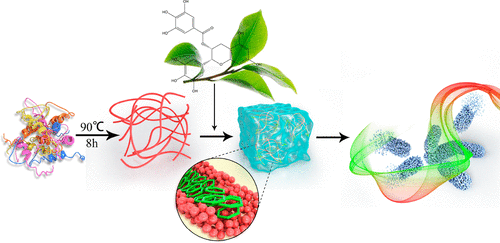Our official English website, www.x-mol.net, welcomes your
feedback! (Note: you will need to create a separate account there.)
Polyphenol-Binding Amyloid Fibrils Self-Assemble into Reversible Hydrogels with Antibacterial Activity
ACS Nano ( IF 15.8 ) Pub Date : 2018-03-19 00:00:00 , DOI: 10.1021/acsnano.7b08969 Bing Hu 1, 2 , Yang Shen 3 , Jozef Adamcik 2 , Peter Fischer 4 , Mirjam Schneider 5 , Martin J. Loessner 3 , Raffaele Mezzenga 2
ACS Nano ( IF 15.8 ) Pub Date : 2018-03-19 00:00:00 , DOI: 10.1021/acsnano.7b08969 Bing Hu 1, 2 , Yang Shen 3 , Jozef Adamcik 2 , Peter Fischer 4 , Mirjam Schneider 5 , Martin J. Loessner 3 , Raffaele Mezzenga 2
Affiliation

|
Adaptable hydrogel networks with reversible connectivity have emerged as a promising platform for biomedical applications. Synthetic copolymers and low-molecular-weight gelators (LMWG) have been shown to form reversible hydrogels through self-assembly of the molecules driven by self-complementary hydrophobic interaction and hydrogen bonding. Here, inspired by the adhesive proteins secreted by mussels, we found that simply adding natural polyphenols, such as epigallocatechin gallate (EGCG) to amyloid fibrils present in the nematic phase, successfully drives the formation of hydrogels through self-assembly of the hybrid supramolecules. The hydrogels show birefringence under polarized light, indicating that the nematic orientation is preserved in the gel phase. Gel stiffness enhances with incubation time and with an increase in molecular ratios between polyphenol and fibrils, fibril concentration, and pH. The hydrogels are shear thinning and thermostable from 25 to 90 °C without any phase transition. The integrity of the trihydroxyl groups, the gallate ester moiety in EGCG, and the hydrophobicity of the polyphenols govern the interactions with the amyloid fibrils and thus the properties of the ensuing hydrogels. The EGCG-binding amyloid fibrils, produced from lysozyme and peptidoglycans, retain the main binding functions of the enzyme, inducing bacterial agglomeration and immobilization on both Gram-positive and Gram-negative bacteria. Furthermore, the antibacterial mechanism of the lysozyme amyloid fibril hydrogels is initiated by membrane disintegration. In combination with the lack of cytotoxicity to human colonic epithelial cells demonstrated for these hybrid supramolecules, a potential role in combating multidrug-resistant bacteria in biomedical applications is suggested, such as in targeting diseases related to infection of the small intestine.
中文翻译:

多酚结合淀粉样蛋白原纤维自组装成具有抗菌活性的可逆水凝胶
具有可逆连接性的适应性水凝胶网络已成为生物医学应用的有前途的平台。合成共聚物和低分子量胶凝剂(LMWG)已显示通过自互补疏水相互作用和氢键驱动的分子自组装形成可逆水凝胶。在这里,受贻贝分泌的粘附蛋白的启发,我们发现,向向列相中存在的淀粉样蛋白原纤维中添加天然多酚(例如表没食子儿茶素没食子酸酯(EGCG))成功地通过杂化超分子的自组装成功驱动了水凝胶的形成。水凝胶在偏振光下显示双折射,表明向列取向保持在凝胶相中。凝胶刚度随孵育时间和多酚与原纤维之间的分子比,原纤维浓度和pH值的增加而增强。水凝胶在25至90°C的温度范围内剪切稀化和热稳定,没有任何相变。三羟基的完整性,EGCG中的没食子酸酯部分以及多酚的疏水性决定了与淀粉样原纤维的相互作用,从而决定了随后的水凝胶的性能。由溶菌酶和肽聚糖产生的结合EGCG的淀粉样原纤维保留了该酶的主要结合功能,诱导细菌团聚并固定在革兰氏阳性和革兰氏阴性细菌上。此外,溶菌酶淀粉样蛋白原纤维水凝胶的抗菌机制是由膜崩解引发的。
更新日期:2018-03-19
中文翻译:

多酚结合淀粉样蛋白原纤维自组装成具有抗菌活性的可逆水凝胶
具有可逆连接性的适应性水凝胶网络已成为生物医学应用的有前途的平台。合成共聚物和低分子量胶凝剂(LMWG)已显示通过自互补疏水相互作用和氢键驱动的分子自组装形成可逆水凝胶。在这里,受贻贝分泌的粘附蛋白的启发,我们发现,向向列相中存在的淀粉样蛋白原纤维中添加天然多酚(例如表没食子儿茶素没食子酸酯(EGCG))成功地通过杂化超分子的自组装成功驱动了水凝胶的形成。水凝胶在偏振光下显示双折射,表明向列取向保持在凝胶相中。凝胶刚度随孵育时间和多酚与原纤维之间的分子比,原纤维浓度和pH值的增加而增强。水凝胶在25至90°C的温度范围内剪切稀化和热稳定,没有任何相变。三羟基的完整性,EGCG中的没食子酸酯部分以及多酚的疏水性决定了与淀粉样原纤维的相互作用,从而决定了随后的水凝胶的性能。由溶菌酶和肽聚糖产生的结合EGCG的淀粉样原纤维保留了该酶的主要结合功能,诱导细菌团聚并固定在革兰氏阳性和革兰氏阴性细菌上。此外,溶菌酶淀粉样蛋白原纤维水凝胶的抗菌机制是由膜崩解引发的。











































 京公网安备 11010802027423号
京公网安备 11010802027423号